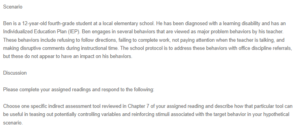Behavior Assessment Tools
One of the tools selected for testing and can be used to test the 12-year-old learner is the Behavior Analytic Problem Solving Interview (BAPS-I). The BAPS-I can help test and control the problem behaviors because of its approach to testing. Steege et al. (2019) state that when using BAPS-I, the tool is developed such that the interviewer begins interviewing the learner on their strengths. This is useful during testing because it helps create a smooth platform for conversation between the interviewer and the interviewee. Besides, the interviewer gathers more information about the client (Kieta et al., 2019). This tool is handy when testing and controlling the target behavior since it helps the interviewer describe it. Steege et al. (2019) noted that sometimes the target behavior can only be identified through labels. Still, by correctly defining the behavior, the interviewer can understand the behavior and initiate the proper intervention, so getting a tool that helps describe the behavior is very important.
Are you looking to get your work done? Reach out to us.
BAPS-I also allows the interviewer to gather information on the environment and the individual, making it possible to understand the relationship between the individual and the background concerning the behavior (Steege et al., 2019). This feature makes BAPS-I useful in testing and creating interventions because the interviewer will be well-equipped with information on all the variables that cause the target behavior, and with such details, proper interventions can be developed (Padilla, 2020). For instance, in the case of Ben, it could be that the 12-year-old displays these problem behaviors only when in a Mathematics class, possibly because of his attitude towards Mathematics. It could also be that these problem behaviors emerge because of the teacher. Therefore, this tool helps reveal these environmental factors related to the problem behavior, thus making it possible to develop the proper intervention.
References
Kieta, A., Cihon, T. M, & Abdel-Jalil, A. (2019). Problem Solving from a behavioral perspective: Implications for behavior analysts and educators. Journal of Behavioral Education 28(10). DOI:10.1007/s10864-018-9296-9
Padilla, K. L. (2020). Global assessment use and practices in applied behavior analysis: Surveying the FIELD. Research in Autism Spectrum Disorders 79:101676 https://doi.org/10.1016/j.rasd.2020.101676
Steege, M.W., Pratt, J.L., Wickerd, G., Guare, R., & Watson, T.S. (2019). Conducting school-based functional behavioral assessments, Third Edition: A practitioner’s guide. Guilford Press.
ORDER A PLAGIARISM-FREE PAPER HERE
We’ll write everything from scratch
Question

Behavior Assessment Tools
Scenario
Ben is a 12-year-old fourth-grade student at a local elementary school. He has been diagnosed with a learning disability and has an Individualized Education Plan (IEP). Ben engages in several behaviors that are viewed as major problem behaviors by his teacher. These behaviors include refusing to follow directions, failing to complete work, not paying attention when the teacher is talking, and making disruptive comments during instructional time. The school protocol is to address these behaviors with office discipline referrals, but these do not appear to have an impact on his behaviors.
Discussion
Please complete your assigned readings and respond to the following:
Choose one specific indirect assessment tool reviewed in Chapter 7 of your assigned reading and describe how that particular tool can be useful in teasing out potentially controlling variables and reinforcing stimuli associated with the target behavior in your hypothetical scenario.

